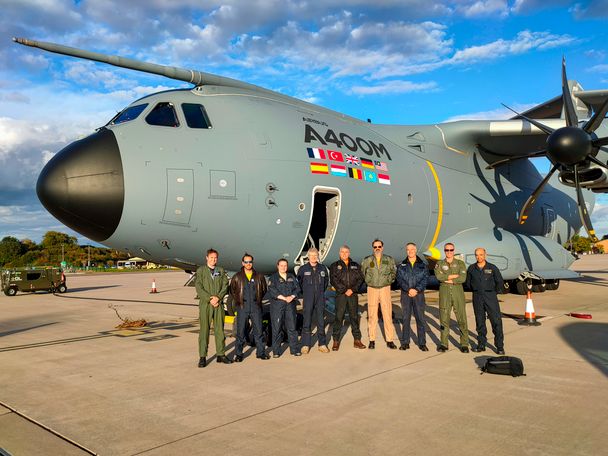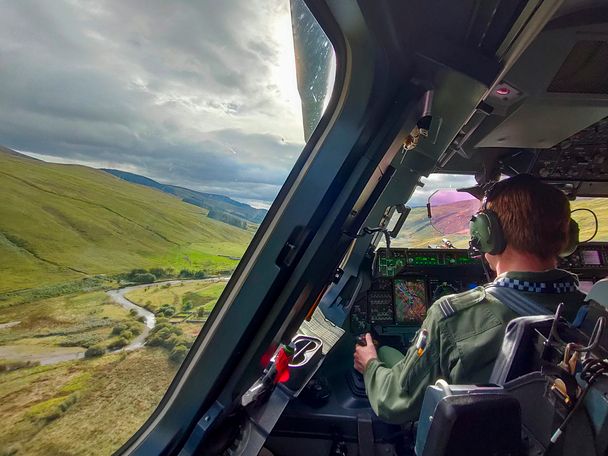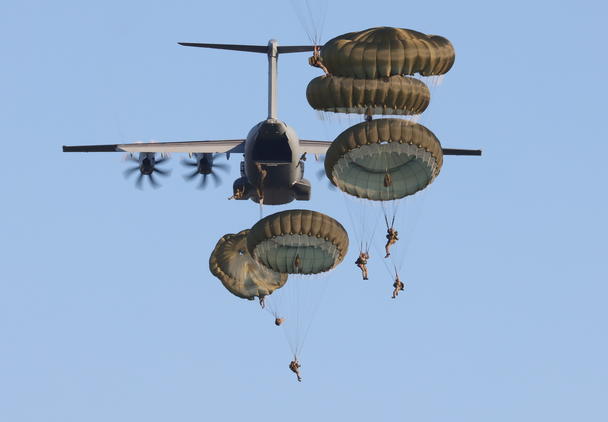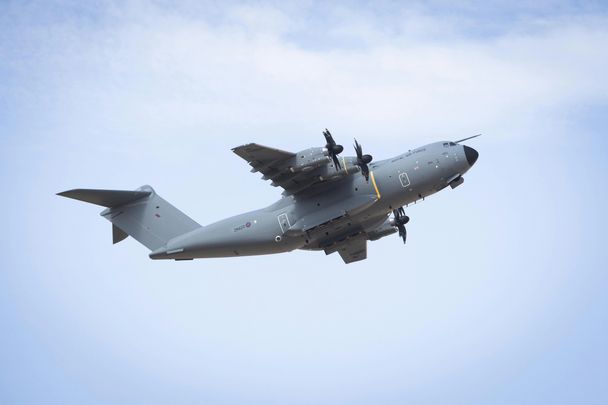Three missions, one aircraft: Airbus A400M shows its potential in the UK

As part of its commitment with the countries operating the A400M under the Organisation for Joint Armament Cooperation (OCCAR), Airbus Defence and Space successfully completed a Crew Workload Assessment mission conducted in the UK. Performed by the Airbus MSN6 prototype, and operated from Royal Air Force (RAF) Brize Norton, the objective was to evaluate the crew workload while performing the three key tactical capabilities ofthe A400Mon one single flight: Aerial Delivery, Low-level Flight and Air-to-air refuelling.
Omne Trinum est Perfectum. This Latin phrase means that everything that comes in `threes´ is perfect, or, every set of three is complete, could be easily applied when referring to the A400M. The aircraft responds to a highly varied needs of world Air Forces and other organisations as it performs three very different types of duties: tactical and strategic missions directly to the site of action, as well as air-to-air refuelling. Three key capabilities that describe the whole potential of an A400M.
On 26 September, the Airbus prototype MSN6 took off from the San Pablo plant in Seville. Its destination: Royal Air Force Brize Norton airfield, our host and witness of this complex mission. The MSN6 proudly shows, painted on its fuselage, the flags of the 10 different countries that already have chosen the A400M. Ahead, one more day for a final check over the flight plan for Wednesday, 28 September.
The A400M can perform missions which previously required two - or more - different types of aircraft, and is capable of manoeuvres that many would not expect from a transport aircraft of its size. The Crew Workload Assessment mission represents the operational summary of the A400M capability, as it includes the workload evaluation of its three key tactical missions and features in flight: Aerial Delivery, Low-level Flight and Air-to-air refuelling. “This mission has particular importance as it provides our customers with distinct confirmation and confidence in the maturity of the A400M as a modern and capable tactical asset,” explained Simon Nicastro, A400M Flight & Integration Test Programme Manager at Airbus.
Crew Workload Assessment: A `3 in 1´ mission
During this exercise, the A400M flexed its muscles over UK skies showing how it excels when it comes to speed and height. Flying over Scotland, the first phase of the flight included aerial refuelling with the MSN6 acting as a receiver from a RAF A330 MRTT Voyager tanker. Rapidly changing operational scenarios required rapid changing configuration and, although it was not tested in this mission, the built-in air-to-air refuelling capability allows the aircraft to be also rapidly reconfigured to become a tanker, an adaptability which is unique to the A400M.
Once refuelled, during the second part of the flight, the MSN6 demonstrated how, despite its weight, it was able to conduct a steep descent and a low-level flight. This unique capability for a military transport aircraft improves the A400M’s terrain masking and survivability, making the aircraft less detectable in hostile areas and less susceptible to threats when cruising towards key military operations.

As part of its commitment with the countries operating the A400M under the Organisation for Joint Armament Cooperation (OCCAR), Airbus Defence and Space successfully completed a Crew Workload Assessment mission conducted in the UK. Performed by the Airbus MSN6 prototype, and operated from Royal Air Force (RAF) Brize Norton, the objective was to evaluate the crew workload while performing the three key tactical capabilities of the A400M on one single flight: Aerial Delivery, Low-level Flight and Air-to-air refuelling.
For the last phase of the flight, the MSN6 showed what it is capable of when `playing´ with both speed and height. During this phase, four loads of 1 tonne each were dropped over a controlled drop zone from the cargo hold. The type’s low-speed characteristics make the A400M ideal for dropping supplies from low altitude, assuring a very rapid and direct response to any occurrence and, once on the ground, is designed for very rapid cargo unloading or loading without any specialised ground support equipment, minimising the aircraft’s vulnerability to hostile action.
This whole mission was conducted by the minimum crew required for the task: two pilots and one loadmaster assisted by two qualified cargo crew, having also on board at the controls the crew authorities from the Certification and Qualification Organisation (CQO) in order to confirm the acceptability of workload results. “During the flight, the crew received a replanning order to avoid a certain area simulating a ground threat, and also to modify the load delivery in order to be representative of a complex operational mission our customers could face in a real scenario,” explained César González, Flight Test Engineer on board. “All objectives were accomplished and the mission was fully successful, revealing that the crew workload was fully acceptable for this kind of complex operation,” he added.
For such a mission, there is an experienced team behind working in perfect harmony with the customer. “This is the last complex campaign to coordinate and execute with our customers, involving a significant amount of Government Furnished Facilities (GFF) provided by the UK MoD and the Royal Air Force, including aerial delivery loads, a Voyager tanker and several military zones. It has been a tremendous effort and a huge success for the entire Airbus team and another example of `We are ONE´ with our customers,” said David Ferro, A400M Chief Engineer at Airbus.
Once the mission was accomplished, the MSN6 headed back to its hangar in Seville, awaiting for the next challenge to come.
Parachuting, another key capability tested by the Royal Air Force with its A400M
Parachuting remains a key capability for current military operations. Recently, paratroopers of the RAF made the first low-level parachute descents from the Royal Air Force’s A400M, as it will be the aircraft to deliver the military’s parachuting capability in 2023.

© Mick Holland
The trials had been planned and delivered by No. 206 Squadron, the RAF’s heavy aircraft test and evaluation squadron and the Joint Air Delivery Test and Evaluation Unit. RAF dispatches from the Parachute Test Team assisted the parachutists in the safe fitting and checking of equipment, conducting final checks prior to despatch, and ensuring the safe despatch of parachutists from the aircraft before recovering their static lines.
The A400M excels in the parachuting role, as it is able to carry more paratroopers over a greater distance, a capability that reinforces the strategic value the A400M already offers to air force operators and society.
The 21st A400M for UK, delivered to the Royal Air Force
With the MSN056 delivered this week to the UK, the Royal Air Force has now taken delivery of 21 of the 22 A400M on order.
Since the first A400M delivery to the UK back in 2014, the Royal Air Force has performed several key missions having this new generation airlifter as a big asset and highlighting its reach and payload. During Kabul´s evacuation, the UK’s RAF evacuated more than 15,000 people with more than 100 evacuation flights, 31 of which were conducted by the A400M. Among others, the RAF also completed a nine-hour round-trip mission with an A400M from the UK to conduct airdrop resupply in support of a UK Army training Exercise in Estonia. After the years, the RAF and the A400M continue its trustful and growing relationship.

The A400M was launched in 2003 to respond to the combined needs of seven European Nations grouped within OCCAR (Belgium, France, Germany, Luxemburg, Spain, Turkey and the UK), with Malaysia joining in 2005. This is one of the major reasons behind its extreme versatility, and the reason why already 10 countries have the new generation airlifter among their fleets.
“The A400M is becoming a key asset for our customers' military air transport activities and operations, and missions like this show that we are always on duty for them, as they are always on duty for everyone else when it matters most”, said Jean-Brice Dumont, Head of Military Air Systems at Airbus Defence and Space.
Airbus with its A400M wants to fulfil the diverse requirements of nations around the globe in terms of military and humanitarian missions for the benefit of society, as those simulated during this exercise in the UK.
See and download all the photos and videos at Media Gallery.
Click here for further information and latest news on the A400M.